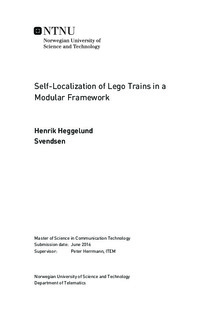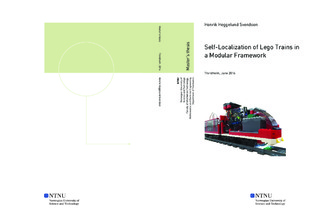| dc.description.abstract | The Department of Telematics of the Norwegian University of Science and Technology has an Intelligent Transportation Systems (ITS) Lab where a model railroad layout built with Lego components is localized. The railroad model has been the center of attention in a series of projects and corresponding theses during the past year, where autonomous systems are developed and deployed on the model railroad. The preceding systems have used a more or less common hardware platform based on the Lego Mindstorms EV3 smart brick. A re-emerging safety issue in these systems has been the self-localization systems, where characteristics related to a color sensor which counts passed railway sleepers acts as a bottleneck.
The focus of this thesis is the self-localization subsystem. To increase flexibility concerning peripheral connectivity, a new hardware platform based on the Raspberry Pi 2 is introduced. To improve the reliability and accuracy of the self-localization in the system, a variety of sensors are introduced, including an NFC reader; an accelerometer; a magnetometer and a color light sensor. Also, a motor controller under the direct control of the Raspberry Pi is used.
As the OSGi framework is central to the chosen modular approach, components from the preceding systems are reused but is not adopted in its totality. Software modules for each of the peripherals are developed and tested, and their suitability as contributors to self-localization purposes are discussed. Summarized, each of the sensors' contributions to self-localization is listed below:
- The NFC reader, combined with Mifare tags encoded with location information placed underneath the railway surface functioning like beacons, stands out as the equipment supplying the most precise and reliable information.
- The color light sensor acts as a minor improvement compared to the one in the preceding projects' platform. Thus, it can aid in making approximated updates to the positional data in between the more precise beacons.
- The magnetometer provides data, which after processing reports the current heading of the train. The calculated heading seems accurate in the initial experiments, but as additional tests reveal it is subject to the fluctuating magnetic interference from the surroundings. The issue of interference may be diminished by physical isolation of the model railroad. Suggestions for improvements are presented, but the heading data is at this point only applicable for coarse position approximations.
- The accelerometer output acceleration measurements, which are analyzed in real-time to calculate changes in velocity. The analysis turns out to be highly vulnerable for deviations in the acceleration readings, resulting in unpredictable outputs. Although efforts are made to mitigate the deviations, satisfactory results are not achieved.
\end{itemize}
\noindent During the phase of testing the mentioned modules, the modular aspects of the architecture are implicitly tested. Sensor modules are easily interchangeable with simulated modules, and published events are used for logging experimental data. | |

